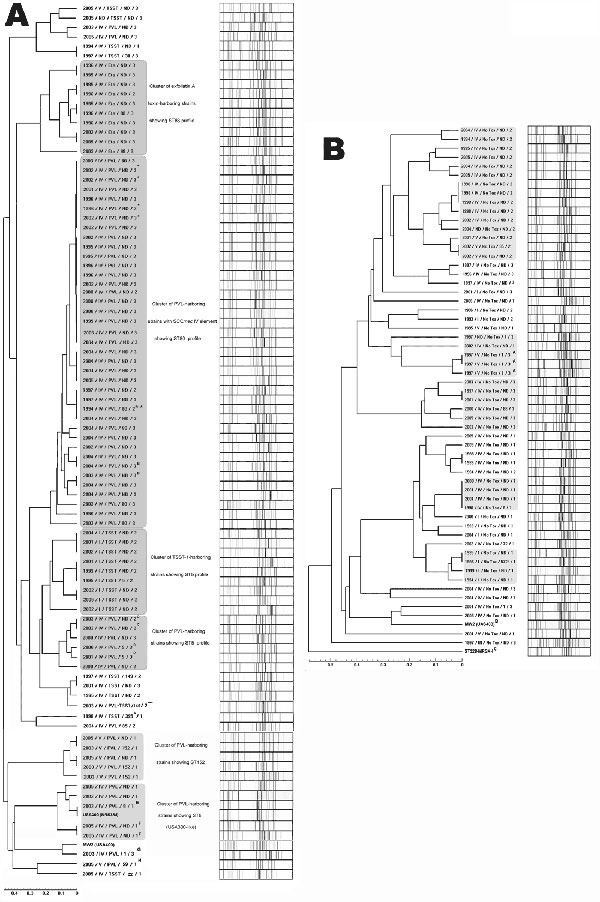Volume 14, Number 2—February 2008
Dispatch
Methicillin-Resistant Staphylococcus aureus, Geneva, Switzerland, 1993–2005
Appendix Figure

Appendix Figure. Clustering trees. A) Trees obtained by using multiple-locus variable-number tandem repeat analysis (MLVA)–based genotyping for strains of Staphylococcus aureus harboring clinically important toxins, Geneva, Switzerland, 1993–2005. Year of isolation, staphylococcal cassette chromosome mec (SCCmec) type, toxin content, multiple locus sequence type, and accessory gene regulator (agr) types are also indicated for each strain (year/SCCmec/ST/agr). Major clusters appear in gray. ND, not determined; NT, nontypeable. *Clonal strains isolated from the familial cluster of ST80-MRSA-IV harboring the Panton-Valentine leukocidin (PVL) gene. **First ST80-MRSA-IV harboring the PVL gene isolated in 1994. ***Aypical ST149 strain clustering with other ST149 isolates, showing 2 toxins. A single locus variant of ST395; B small familial clusters of clonal strains isolated in 2 pairs of relatives; C and D 2 pairs of clonal strains from a neonatology cluster previously described (7); E patients returning from New York infected with USA300; F clusters of isolates from 2 prison inmates; G the only patient (intravenous drug user) with a strain highly related to USA400; H isolate showing molecular content of the ST59 Pacific clone. Scale bar (lower left) shows relative distance between strains. B). Trees obtained by using MLVA-based genotyping for strains devoid of clinically important toxins. Year of isolation, SCCmec type, toxin content, MLST, and agr types are also indicated for each strain (year/SCCmec/ST/agr). A familial cluster of ST1-MRSA-V composed of a mother and her 2 children; B control strain MW2 (USA400); C control strain ST228-MRSA-I representing the common nosocomial strain in our area. Scale bar (lower left) shows relative distance between strains.
References
- Tristan A, Ferry T, Durand G, Dauwalder O, Bes M, Lina G, Virulence determinants in community and hospital methicillin-resistant Staphylococcus aureus. J Hosp Infect. 2007;65(Suppl 2):105–9. DOIPubMedGoogle Scholar
- Harbarth S, Francois P, Schrenzel J, Fankhauser-Rodriguez C, Hugonnet S, Koessler T, Community-associated methicillin-resistant Staphylococcus aureus, Geneva, Switzerland. Emerg Infect Dis. 2005;11:962–5.PubMedGoogle Scholar
- Dufour P, Gillet Y, Bes M, Lina G, Vandenesch F, Floret D, Community-acquired methicillin-resistant Staphylococcus aureus infections in France: emergence of a single clone that produces Panton-Valentine leukocidin. Clin Infect Dis. 2002;35:819–24. DOIPubMedGoogle Scholar
- Durand G, Bes M, Meugnier H, Enright MC, Forey F, Liassine N, Detection of new methicillin-resistant Staphylococcus aureus clones containing the toxic shock syndrome toxin 1 gene responsible for hospital- and community-acquired infections in France. J Clin Microbiol. 2006;44:847–53. DOIPubMedGoogle Scholar
- Sax H, Posfay-Barbe K, Harbarth S, Francois P, Touveneau S, Pessoa-Silva CL, Successful control of a cluster of community-associated, methicillin-resistant Staphylococcus aureus in neonatology. J Hosp Infect. 2006;63:93–100. DOIPubMedGoogle Scholar
- Aramburu C, Harbarth S, Liassine N, Girard M, Gervaix A, Scherenzel J, Community-acquired methicillin-resistant Staphylococcus aureus in Switzerland: first surveillance report. Euro Surveill. 2006;11:42–3.PubMedGoogle Scholar
- Harbarth S, Sax H, Fankhauser-Rodriguez C, Schrenzel J, Agostinho A, Pittet D. Evaluating the probability of previously unknown carriage of MRSA at hospital admission. Am J Med. 2006;119: 275.e15–23. DOIPubMedGoogle Scholar
- Clinical and Laboratory Standards Institute (CLSI). Performance standards for antimicrobial susceptibility testing; 15th informational supplement M100–S15. Wayne (PA): The Institute; 2005.
- Francois P, Pittet D, Bento M, Pepey B, Vaudaux P, Lew D, Rapid detection of methicillin-resistant Staphylococcus aureus directly from sterile or nonsterile clinical samples by a new molecular assay. J Clin Microbiol. 2003;41:254–60. DOIPubMedGoogle Scholar
- Francois P, Renzi G, Pittet D, Bento M, Lew D, Harbarth S, A novel multiplex real-time PCR assay for rapid typing of major staphylococcal cassette chromosome mec elements. J Clin Microbiol. 2004;42:3309–12. DOIPubMedGoogle Scholar
- Francois P, Koessler T, Huyghe A, Harbarth S, Bento M, Lew DP, Rapid Staphylococcus aureus agr type determination by a novel multiplex real-time quantitative PCR assay. J Clin Microbiol. 2006;44:1892–5. DOIPubMedGoogle Scholar
- Enright MC, Day NP, Davies CE, Peacock SJ, Spratt BG. Multilocus sequence typing for characterization of methicillin-resistant and methicillin-susceptible clones of Staphylococcus aureus. J Clin Microbiol. 2000;38:1008–15.PubMedGoogle Scholar
- Smith JM, Cook GM. A decade of community MRSA in New Zealand. Epidemiol Infect. 2005;133:899–904. DOIPubMedGoogle Scholar
- Shukla SK, Stemper ME, Ramaswamy SV, Conradt JM, Reich R, Graviss EA, Molecular characteristics of nosocomial and Native American community-associated methicillin-resistant Staphylococcus aureus clones from rural Wisconsin. J Clin Microbiol. 2004;42:3752–7. DOIPubMedGoogle Scholar
- Berglund C, Molling P, Sjoberg L, Soderquist B. Predominance of staphylococcal cassette chromosome mec (SCCmec) type IV among methicillin-resistant Staphylococcus aureus (MRSA) in a Swedish county and presence of unknown SCCmec types with Panton-Valentine leukocidin genes. Clin Microbiol Infect. 2005;11:447–56. DOIPubMedGoogle Scholar